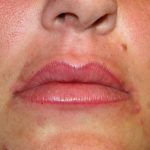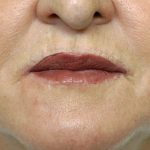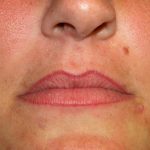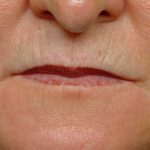1. What is the difference between lip enhancement and lip augmentation?
Most people, including plastic surgeons, often use these lip terms interchangeably. While one could argue no matter what you call it, the idea is to make the lip look better… which usually means fuller. However, there are some subtle differences between lip augmentation and enhancement. Lip augmentation adds or restores fullness to the lips. This can be done with either temporary injectable fillers or permanent materials. Enhancement procedures do not really add fullness, although they do make the lip look bigger. These are skin removal procedures that change the position and shape of the vermilion, thus enhancing the appearance of the lip.
2. What is the best injectable filler for lip augmentation?

3. Are there any permanent options for making my lips bigger?
The desire for a permanent lip ‘filler’ is a common one and there are some options. There is no easy injectable method, however, for lip augmentation that is absolutely permanent. None off-the-shelf injectables are permanent. At best, some may last as long as nine to twelve months.
Fat is often injected into the lips because it is your own tissue and particularly if one is in the operating room for other procedures anyway. The downside to fat injections into the lips is that its survival is unpredictable. I have seen some patients in my Indianapolis plastic surgery practice who have done really well with it while many others have gone on to near complete resorption. It’s worth a try if you are already in the operating room but any long-term retention should be thought of as a bonus, not an absolute. It is not a procedure that can be done in the office.
Implants have been tried over the years in the lips as a permanent filler, of which Gore-Tex (polytetrafluoroethylene) is the most commonly used. Different variations and designs of this material have been used over the years. The best one that I have used is Advanta, which is a very soft and spongy tube of various diameters. When well placed deep in the lip, it can be a very reliable and effective method for permanent lip enlargement.
4. I have very thin lips that have no shape. I have tried injectable fillers but they didn’t work. Is there anything I can do?
Injectable fillers work when there is sufficient vermilion or lip tissue to expand. In very thin lips, fillers can often make for an unnatural ‘duckbill’ look because there is not enough vermilion to expand out naturally. Unless the filler is done in small amounts, the lips can assume an unusual bloated appearance.

The other vermilion changing procedure is the lip lift, also known as the ‘bullhorn’ lip procedure.In an effort to avoid a lip scar, the skin removal is done right under the nose placing the scar in the hidden crease between the lip and the nose. By removing skin in this area, the vermilion of the lip below is pulled up increasing its pout. The disadvantages of the lip lift is that it affects only the central part of the lip and it will lose some percent of the created lip fullness after surgery. (due to gravity)
5. Can lip procedures be done in the office?
Any type of lip procedure, injection, implant, or surgery, can easily be done in the office. The lips can very effectively be numbed by the injection of local anesthetics, just like in the dental office. For patients who are anxious about those type of injections, oral sedation medications can be provided which will definitely alleviate any apprehension that one may have. If you take sedation, you will need someone to drive you home.
Injection procedures take about 15 minutes to perform. The placement of lip implants takes about 30 minutes. Lip lifts or lip advancements will take about 60 to 90 minutes to perform.
6. Is there much pain and swelling after lip augmentation procedures?
Depending upon the technique used, the amount of swelling and discomfort afterwards changes. Injectable fillers result in no pain and very little swelling after. Lip implants cause considerable swelling for a week or so and have some mild discomfort from fullness and stiffness. Lip lifts and advancements cause much less swelling than implants and virtually no pain.
Recovery from lip procedures is essentially ‘social’, meaning how you look. There are no restrictions of any activities including eating and drinking.
Dr. Barry Eppley
Indianapolis, Indiana




